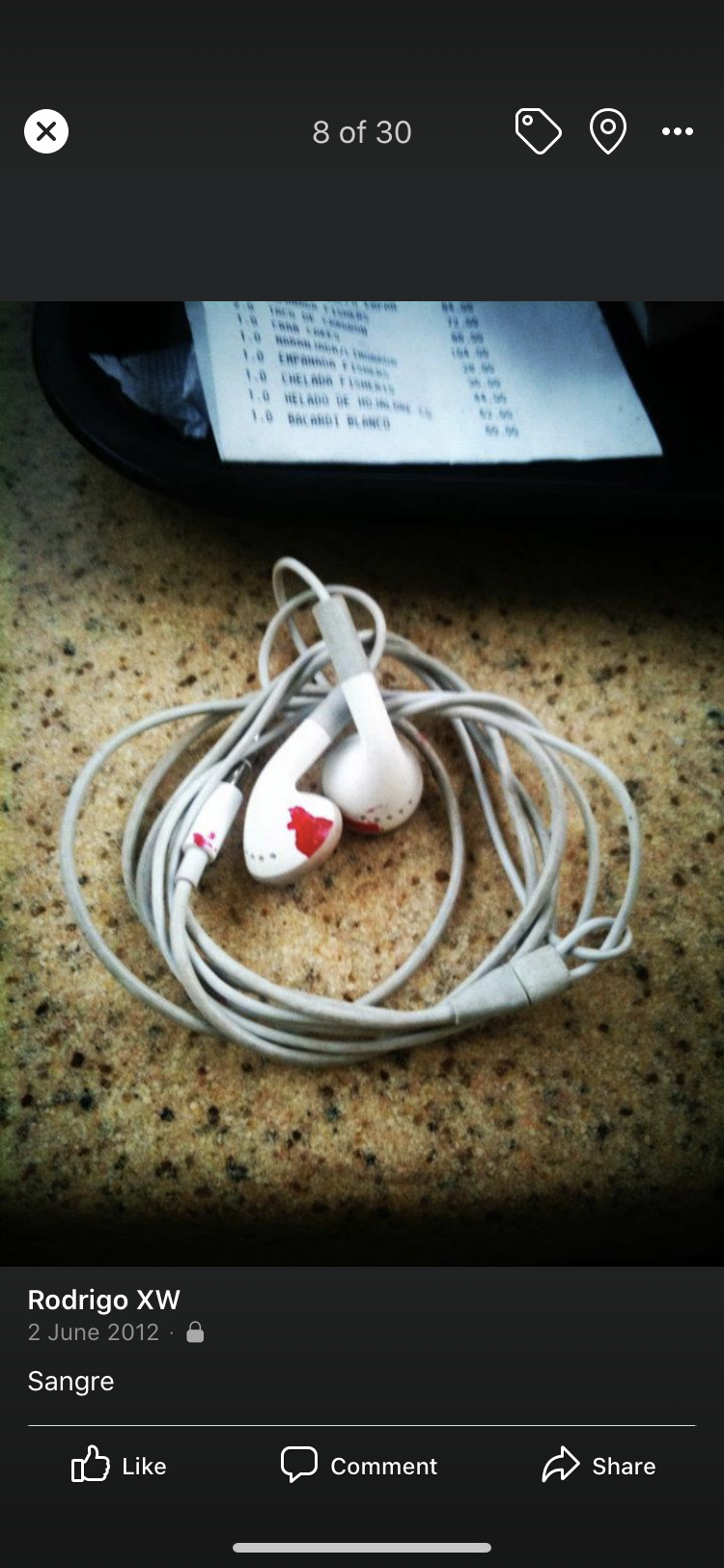#picplz
Text
Digital New Year’s Resolutions
For part of my (digital) New Year’s Resolutions this year, I decided to delete my accounts on social media services that I don’t use. (Although I would love to cut Facebook, that’s probably not going to happen.) I love trying out new social media goodies, but it’s impossible for me to keep up with all of them. So over the course of the year I am going to try and use the services I belong to, and if I don’t, they’re getting cut.
First on the list and certainly, definitely cut, is dailybooth, which I never use, find sort of narcissistic, and is pretty much just full of teenage cam whores and amateur porn (although really, what else would you expect). The rest of the list is, so far:
dailybooth
flickr
picplz
foursquare
posterous
flavors.me
google+
readernaut
goodreads
linkedin
0 notes
Text









Fotos de 2012, de cuando se murió Picplz y me llevé mis pics a Facebook ( 1 / 2 )
1 note
·
View note
Photo

New flickr fav! Umbrella spoon! by lauriebreaker https://flic.kr/p/aqiN5E
0 notes
Text
Красивые фото со всего мира
Красивые фото со всего мира
Taken with picplz in Brasília.
Posted by carlaarena on 2011-03-03 12:17:59
Tagged: , picplz , 2011 , march2011 , beauty , beautyproject
View On WordPress
#2011#amazing#beautiful#beauty#beautyproject#best photo#bounty#brilliant#jewelry#lucky man#march2011#nature#perfect body#perfect world#picplz#pretty woman
0 notes
Text
Sites Similar to Instagram

Currently, Instagram is a warm subject. After Facebook took control of it for $1bn, the options of this photography sharing internet site are being looked for by its followers. Likewise, all of a sudden there has been an explosion of applications that provide some extra attributes aside from the normal feature. We located the complying with interesting alternatives checking out the results of comparable websites to instagr.am.
Hipstamaticapp.com
Hipstamatic is a preferred app and also it has been existing considering that 2009. In 2010, it was even named the app of the season by Apple! Images that have not been caught while using this app can't be edited on Hipstamatic. This is its one downside. The requirement of the filters is what truly sets Hipstamatic besides the multitudes of lesser vintage look applications. The application has several 'lenses' provided, each of them providing an unique vintage appearance, with a few 'movies' and also 'flashes' likewise offered to boost the effects.The alternative of printing the picture is likewise offered which isn't viable with Instagram. The app, though aesthetically created, takes some time to getting familiar with. Hipstamatic isn't free of charge like the various other applications, as well as the basic version of the application costs about $1.99 to download and install.
Picplz.com
Virtually the same service to Instagram that allows you share your photos through Facebook and twitter with their app and also supplies a range of filter systems to place above the pictures which once again, aren't different from Instagram. The two essential benefits of Picplz.com are that although Instagram downgrades the top quality of your main pictures, Picplz maintains the preliminary high quality. When looking at images on larger screens or when published, this makes a considerable difference. The following benefit of Picplz.com is that unlike Instagram, they've got an effective internet presence from where you can examine your images with an on the internet photo album telephone call Flipboard which oganises the images collectively in a fascinating and also nice technique.
Dailybooth.com
Dailybooth encourages individuals to have one significant discussion about your life time in images. Over-all, it's a truly similar application to Instagram but similar to Picplz.com, Dailybooth also possess a robust internet site to check out your very own as well as your friends' archived photos. The main distinction amongst them is perhaps their frame of mind - while Instagram consumers will certainly want to discover remarkable things that will certainly look appealing with a filter on, Dailybooth users make use of their thing by using it as a diary that submits their every day regimens.
Flickr.com
Even though Flickr is greater recognized as an on the internet solution to keep high resolution images, Yahoo! revealed its really first Android Flickr app in September 2011 that had lots of Instagram-like filter systems. This application consists of a task stream to ensure that you can take a look at latest images from your friends in real-time and surf with all their earlier sets and selections, along with your own. Similar to with Instagram, you have the ability to view likes, remarks as well as on top of that it is feasible to check out a map to uncover precisely where the pictures were caught. Like with Instagram, pictures could be shared on Facbook as well as Twitter. Sadly, the filter systems aren't accessible on Flickr's iphone application yet, so not truly the best option for apple iphone users.
The app has a number of 'lenses' offered, each of them offering an unique vintage appearance, with a few 'films' and 'flashes' likewise offered to enhance the effects.The option of publishing the picture is likewise used which isn't possible with Instagram. Hipstamatic isn't complimentary of cost like the other apps, and also the standard version of the app costs regarding $1.99 to download and install.
Virtually similar service to Instagram that allows you share your images through Facebook as well as twitter with their app as well as supplies a variety of filter systems to put above the photos which when again, aren't various from Instagram. Over-all, it's a really similar application to Instagram however simply like Picplz.com, Dailybooth likewise have a durable web website to look at your very own and also your good friends' archived images. The main distinction among them is possibly their mindset - while Instagram consumers will certainly look to discover fascinating things that will certainly look eye-catching with a filter on, Dailybooth customers take advantage of their thing by using it as a journal that submits their every day regimens.
1 note
·
View note
Text
A.Capital Partners, founded by Ronny Conway, targets $140 million for its third fund
Silicon Valley investor Ronny Conway is raising his third early-stage venture fund, shows a new SEC filing that states the fund’s target is $140 million and that the first sale has yet to occur.
The now six-year-old firm, A.Capital, focuses on both consumer and enterprise tech, and has offices in Menlo Park and San Francisco.
Among the many brand-name companies in its portfolio are Coinbase, Airbnb, Pinterest, and Reddit. (You can find its other investments here.)
Conway led the seed-stage program of Andreessen Horowitz (a16z) for roughly four years in its earliest days and left in 2013 to raise his debut fund, which closed with $51 million in capital commitments. He also raised two, smaller parallel funds at the time.
According to SEC filings, he sought out $140 million for his second fund, though he never announced its close.
A.Capital is today run by Conway, along with General Partner Ramu Arunachalam (also formerly of a16z) and Kartik Talwar, who worked previously with Conway’s brother, Topher, and his famed father, Ron, at their separate venture firm, SV Angel.
Conway maintains a far lower profile than his father in particular, who throughout his venture career has nurtured relationships not only with founders but with tech reporters and local politicians.
Though now ancient history in Silicon Valley years, Ronny Conway was credited with introducing Andreessen Horowitz to Instagram during its earliest days.
Conway, a former Googler, met Instagram cofounder Kevin System in the several years when he, too, worked for the search giant, beginning in 2006. It turned out to be a highly worthwhile introduction, though it could have been even lucrative for a16z.
Though the firm made a seed-stage bet on the what was then a far simpler mobile photo-sharing app, a16z never followed up with another check because of investment in another photo-sharing startup that would eventually flounder (PicPlz).
It was a sensitive issue at the time for a16z, with some noting its missed opportunity. In fact, Ben Horowitz later felt compelled to write in a blog post that Andreessen Horowitz made $78 million from its $250,000 seed investment in Instagram when Facebook acquired it $1 billion in 2012.
0 notes
Text
Sites Similar to Instagram

As of that moment, Instagram is now a popular topic. Once Facebook took over it for about 1bn, the alternatives with the photography sharing web site have been hunted with its own followers in video downloader app. Unexpectedly there has been an explosion of software offering some features apart from the normal characteristic. We all found that the subsequent interesting alternatives taking a look in the results of similar sites to instagram downloader app.
Hipstamatic is a wildly popular program also it has been current because 2009. Back in 2010it had been named the program of the season by Apple! While using the this program photos which haven't been recorded can't be edited on Hipstamatic. That really is actually its only disadvantage. The quality of this blockers is what sets Hipstamatic apart from the myriads of vintage look insta downloader app. The app offers several'lenses' offered, all those giving a distinctive vintage look, using a few' films' and 'flashes' also available to enhance the effects.The alternate of printing the picture will be additionally offered which isn't feasible with downloader for instagram app. To becoming accustomed to, the program, even nevertheless aesthetically designed, takes the time. Hipstamatic is not without any charge similar to the other apps, and the simple variant of this program costs about $1.99 to download.
Virtually identical assistance to video downloader for instagram app that permits you to share your photographs through Facebook and twitter with their program and offers a number of filtration systems to automatically put above the images that once again, aren't separate from Instagram. The two key advantages of all Picplz.com are that even though save videos from instagram app downgrades the level of one's principal photographs, the Picplz retains the initial quality. This creates a differentiation if printed or when looking at images on screens that are bigger. The next benefit of Picplz.com is the fact that compared to Instagram, they have a effective presence from in which you can appraise your images having an on-line photoalbum call Flipboard which oganises the images jointly at a nice and intriguing method in video downloader for instagram android app on google play. Checkout this instagram downloader app.
Dailybooth inspires visitors to have a huge discussion on your lifetime in pictures. Over all, it's really a similar app on video downloader for instagram app on google play but only like Picplz.com, Dailybooth also have a solid web site to have a look at your personal and friends and family' archived images. The main differentiation amongst these is possibly their mentality - whilst video downloader for instagram app from play store consumers will check out seek out Dailybooth consumers take advantage of these thing.
Even although Flickr is greater known as an internet support to maintain highresolution photos, Yahoo! exposed its very first Android Flickr program in September 2011 that had plenty of video downloader for instagram android app -like filter techniques. This program includes an activity flow to make certain you are able to glance at latest photos out of your buddies in browse and real time through selections and most of their sets, in addition to your own. The same as using video downloader app, you are able to see enjoys and also it's possible to check in a map where in fact the images were captured to discover. As with Instagram, pictures could possibly be shared around Facbook and Twitter. Sadlythe filtration systems aren't reachable on Flickr's iOS program but, so not really the most important substitute for iPhone people.
0 notes
Text
BEST WAY TO PROMOTE AN iOS APPS

Actually i have studied a bunch of successful iPhone and ipad launches up close , for instance, Siri, that app purchased for more than than 200 dollars million only a couple of week after it launched, so i do say that was a successful launch. Above is chase Jarvis launching his “Best camera” app that was a successful before it got beaten by intagram, path, and picplz.
We all know that there are…
View On WordPress
0 notes
Text
Instagram just ruined Instagram
Image: Christopher Mineses/Mashable
By Pete Pachal2017-02-01 22:02:22 UTC
Instagram, the popular social network based around sharing photos, died suddenly on Tuesday. The service was 6 years old.
The cause of death was trying to be everything to everyone, a condition it had suffered for months but had been managing quite well. Despite its status as both a top-rated app in Apple's App Store and one of Facebook's prized acquisitions, Instagram couldn't find a path that remained true to its original mission, a fact that became evident when a new beta version of the app showed the service was experimenting with a way to share albums of photos, as opposed to a singular image.
Born in late 2010, Instagram was accused of being a ripoff of other photo-sharing apps, including Hipstamatic and PicPlz, though it soon bested them all. While it took a while for Instagram to establish its dominance, it did so on the strength of its simplicity and the filters it became synonymous with. After Facebook paid a then-unheard-of $1 billion for the service in 2012, Instagram went on to even greater success, passing 500 million users in 2016, making its death that much more painful.
Over the past year, Instagram had expanded its features considerably by introducing Likes for comments, live video and the blatant Snapchat copy, Stories. But through all those changes, it generally left its primary service — sharing photos with friends and followers — unaffected. Each new feature increased engagement with many of its users and opened up new potential for revenue. But for those who wished to only share and view photos, they could simply ignore the new tools.
Instagram is... was about sharing a single, perfect pic that encapsulates the moment you’re experiencing.
Albums is poised to change that. The feature flies in the face of Instagram's inherent curation, potentially allowing users to share up to 10 photos in a single post. Overlooking that there are literally hundreds of services that already do that — most notably its own parent, Facebook — Instagram had clearly lost touch with what its users actually want.
Instagram is... was about sharing a single, perfect pic that encapsulates the moment you’re experiencing. While some users have been known to share multiple photos of cruises, museum visits and trips to the dentist, those users were penalized with scorn, their posts rarely getting the necessary 11 Likes to obfuscate usernames (a feature that was discarded over the past year). Those who didn't adjust to Instagram's unwritten rules and continued to share de facto albums were unfollowed, ostracized from the true Instagram community.
Albums are destined to turn Instagram into a place where tedious photo sets from vacations, bar mitzvahs and holiday parties are interspersed with the images users actually want to see. The dilution is tragically inevitable, and, in the long term, not survivable. With albums, Instagram's soul won't be so much crushed as made fully indistinguishable from Facebook. The service will no longer stand for anything, and while it will continue to exist, and possibly even grow, its core will be rotten, its purpose unclear, its engagement hollow.
The beta nature of the feature might have provided Instagram's users some hope that the popular service could be resuscitated, but it was false hope. The test laid bare a simple truth: That Instagram's insatiable desire for engagement and user-generated content had grown so out of control that it forgot what made its service popular in the first place.
Instagram is survived by its offspring, Hyperlapse, Layout and Boomerang. It will be buried in the GetJar app store in a small ceremony attended by its adoptive parent, Facebook, as well as siblings WhatsApp and Messenger. Instead of flowers, the family encourages donations to Snapchat's IPO. Selfies will not be allowed.
Let's block ads! (Why?)
- Repost from: mashable Post
0 notes
Text
Politics Reading Response
Politics
Summary
Activism in the Social Media Age
Social media has transformed the organization of social change. The hashtag #BlackLivesMatter was first used after the death of Trayvon Martin, a black teenager in 2013. This hashtag, although over five years old, is still used online. It has been posted over 30 million times on Twitter and around 17,000 times a day. Hashtags have continually been created in order to bring awareness toward social issues such as, race, violence and law enforcement. These tweets spark conversations about the topic and inform millions of people. Many accounts that tackle these ideas are important for engaging with the public and 69% of Americans agree. Underrepresented groups are given a voice on social media platforms. They have the power to communicate with the public and spread important information. Many people use social media as their choice to receive news. Social media has also played a role in raising awareness toward sexual harassment and assault by sharing the hashtag #MeToo. People engage online by sharing the information, changing their profile pictures in support of a cause or creating groups to rally or protest for or against issues. In 2018, 53% of United States adults engaged in social change using one of these methods in the next year. The younger generations use these platforms more frequently and find it important to engage with the platforms. Social media also plays a role in politics. Users are able to post the issues that are most important to them to get the attention of elected officials.
A Basic Mobile Apps Arsenal for Activists
Technology has become a major resource for people around the world. Not only is it used for communication but for sharing images, spreading information and protecting yourself. The authors recommend sharing photos using PicPlz. This app syncs to multiple social media accounts and posts the same information, to reach even more people. Bambuser is an app that shares videos. When using this app, you can live stream on multiple platforms at a time. There have been many cases where governments have shut down the internet. iPadio allows you to send updates using text messaging. There are many apps that have been created to protect people all around the world.
Relevant Technology
There are many apps that can spark social change. Twitter has become one of the top platforms for spreading information about issues both locally and globally. People can create hashtags, post information and connect with other users. There are also apps that are geared specifically toward politics. Countable is an app that allows users to see what their government is working on. You can review upcoming votes and post your opinions. You can register to vote and contact your representatives. This apps brings a sense of community to politics, not only can you connect with your friends but with congress. The application has over 4,000 reviews and a 4.5-star rating.
Discussion Questions
1. Do you follow politicians on Twitter? Why or why not?
2. Do you repost social issues on your social media?
3. Where do you get your news from?
0 notes
Link
In 1990, Kleiner Perkins rejected 99.4% of the proposals it received, while investing in 12 new companies a year. Those investees made Kleiner Perkins “the most successful financial institution in the history of the world,” boasting “returns of about 40 percent per year, compounded, for coming up on thirty years.”
Nowadays, the Valley’s VC poster child is now Y Combinator, who invest in more like 250 companies annually. They’re famously selective, accepting something like 1.5% of applicants, but still noticeably less selective than Kleiner Perkins in its heyday. They invest less money (though not necessarily that much less; KP bought 25% of Netscape for a mere $5 million back in 1994) in more companies.
In 1995, three networks controlled essentially all American television, and made only enough to fill the week; nowadays there is so much TV that you could bingewatch a new scripted series every day of the year. In 1995, the top ten movies of the year were responsible for 14% of the total box office. So far in 2018, the top ten have claimed a full 25% of the total gross. Something similar happened in publishing; the so-called “midlist” was largely replaced by a “bestseller or bust” attitude.
In 1995, if you were a journalist, your readership was dictated almost entirely by who published you. No matter how compelling your piece in the Halifax Daily News may have been, the same number of people would glance at your headline as at the others in that issue, and that number would be drastically smaller than that of any article, no matter how buried, in the New York Times. Now, the relative readership of any article, both between and within publications, is determined mostly by social media sharing, and inevitably follows a power-law curve, such that a surprisingly small number of pieces attract the lion’s share of readers.
What do these fields have in common? The number of “hits” has remained relatively constant, while their value has grown, and the number of “swings” has grown to the point where it is difficult for any person, or even any group, to pay close attention to them all. And the outcomes inevitably follow a power law. So it doesn’t make sense to focus on individual outcomes any more; instead you focus on cohorts, and you think stochastically.
“Stochastic” means “randomly determined,” and your initial inclination may be to recoil — of course producers and investors and publishers aren’t acting randomly! They put enormous amounts of analysis, effort, and intelligence into what they do! Which is true. But I put it to you that as gatekeepers’ power has diminished, and the number of would-be directors, CEOs, and pundits has skyrocketed, while the costs of trying have shrunk — randomness has become a more and more important factor.
It’s easy to cite anecdotes. What if Excite had bought Google when it was offered to them for $1 million? How far were we, really, from a world in which Picplz succeeded and Instagram failed? Any honest success story will include elements of luck, which is, in this context, another word for randomness. My contention is that the world’s larger trends — greater interconnectedness, faster speed, democratized access to technology — make randomness an ever-more-important factor.
This is not automatically a good thing. People talk about “stochastic terrorism,” a.k.a. “The use of mass public communication, usually against a particular individual or group, which incites or inspires acts of terrorism which are statistically probable but happen seemingly at random.” Think of killers who dedicate their attack to ISIS after the fact despite no previous communication with them, or, more generally and contentiously, political violence promoted by broadcasting hatred and extremism.
And it seems that climate change is increasingly a stochastic disaster. Warmer weather means more energy in the atmosphere, which means more volatile behavior, which means more catastrophes like droughts, wildfires, hurricanes. Does climate change cause those things? Not directly. It increases the probability of them happening. It means both more and bigger hits, if you will.
This doesn’t apply to every field of human endeavor. But it seems to apply to essentially every field driven by unusual, extreme successes or failures — to Extremistan, to use Nassim Taleb’s term. Extremistan seems to everywhere be growing more extreme, and there’s no end in sight.
via TechCrunch
0 notes
Text









Fotos de 2012, de cuando se murió Picplz y me llevé mis pics a Facebook ( 2 / 2 )
1 note
·
View note
Text
Welcome to the stochastic age
In 1990, Kleiner Perkins rejected 99.4% of the proposals it received, while investing in 12 new companies a year. Those investees made Kleiner Perkins “the most successful financial institution in the history of the world,” boasting “returns of about 40 percent per year, compounded, for coming up on thirty years.”
Nowadays, the Valley’s VC poster child is now Y Combinator, who invest in more like 250 companies annually. They’re famously selective, accepting something like 1.5% of applicants, but still noticeably less selective than Kleiner Perkins in its heyday. They invest less money (though not necessarily that much less; KP bought 25% of Netscape for a mere $5 million back in 1994) in more companies.
In 1995, three networks controlled essentially all American television, and made only enough to fill the week; nowadays there is so much TV that you could bingewatch a new scripted series every day of the year. In 1995, the top ten movies of the year were responsible for 14% of the total box office. So far in 2018, the top ten have claimed a full 25% of the total gross. Something similar happened in publishing; the so-called “midlist” was largely replaced by a “bestseller or bust” attitude.
In 1995, if you were a journalist, your readership was dictated almost entirely by who published you. No matter how compelling your piece in the Halifax Daily News may have been, the same number of people would glance at your headline as at the others in that issue, and that number would be drastically smaller than that of any article, no matter how buried, in the New York Times. Now, the relative readership of any article, both between and within publications, is determined mostly by social media sharing, and inevitably follows a power-law curve, such that a surprisingly small number of pieces attract the lion’s share of readers.
What do these fields have in common? The number of “hits” has remained relatively constant, while their value has grown, and the number of “swings” has grown to the point where it is difficult for any person, or even any group, to pay close attention to them all. And the outcomes inevitably follow a power law. So it doesn’t make sense to focus on individual outcomes any more; instead you focus on cohorts, and you think stochastically.
“Stochastic” means “randomly determined,” and your initial inclination may be to recoil — of course producers and investors and publishers aren’t acting randomly! They put enormous amounts of analysis, effort, and intelligence into what they do! Which is true. But I put it to you that as gatekeepers’ power has diminished, and the number of would-be directors, CEOs, and pundits has skyrocketed, while the costs of trying have shrunk — randomness has become a more and more important factor.
It’s easy to cite anecdotes. What if Excite had bought Google when it was offered to them for $1 million? How far were we, really, from a world in which Picplz succeeded and Instagram failed? Any honest success story will include elements of luck, which is, in this context, another word for randomness. My contention is that the world’s larger trends — greater interconnectedness, faster speed, democratized access to technology — make randomness an ever-more-important factor.
This is not automatically a good thing. People talk about “stochastic terrorism,” a.k.a. “The use of mass public communication, usually against a particular individual or group, which incites or inspires acts of terrorism which are statistically probable but happen seemingly at random.” Think of killers who dedicate their attack to ISIS after the fact despite no previous communication with them, or, more generally and contentiously, political violence promoted by broadcasting hatred and extremism.
And it seems that climate change is increasingly a stochastic disaster. Warmer weather means more energy in the atmosphere, which means more volatile behavior, which means more catastrophes like droughts, wildfires, hurricanes. Does climate change cause those things? Not directly. It increases the probability of them happening. It means both more and bigger hits, if you will.
This doesn’t apply to every field of human endeavor. But it seems to apply to essentially every field driven by unusual, extreme successes or failures — to Extremistan, to use Nassim Taleb’s term. Extremistan seems to everywhere be growing more extreme, and there’s no end in sight.
Via Jon Evans https://techcrunch.com
0 notes
Text
Cheap Internet Service near 62553 Illinois
Perhaps we're seeing the second turn of the photo-ego phenomenon with Instagram, Picplz, Pixable, Path and now Color. ...
0 notes
Text
Welcome to the stochastic age
In 1990, Kleiner Perkins rejected 99.4% of the proposals it received, while investing in 12 new companies a year. Those investees made Kleiner Perkins “the most successful financial institution in the history of the world,” boasting “returns of about 40 percent per year, compounded, for coming up on thirty years.”
Nowadays, the Valley’s VC poster child is now Y Combinator, who invest in more like 250 companies annually. They’re famously selective, accepting something like 1.5% of applicants, but still noticeably less selective than Kleiner Perkins in its heyday. They invest less money (though not necessarily that much less; KP bought 25% of Netscape for a mere $5 million back in 1994) in more companies.
In 1995, three networks controlled essentially all American television, and made only enough to fill the week; nowadays there is so much TV that you could bingewatch a new scripted series every day of the year. In 1995, the top ten movies of the year were responsible for 14% of the total box office. So far in 2018, the top ten have claimed a full 25% of the total gross. Something similar happened in publishing; the so-called “midlist” was largely replaced by a “bestseller or bust” attitude.
In 1995, if you were a journalist, your readership was dictated almost entirely by who published you. No matter how compelling your piece in the Halifax Daily News may have been, the same number of people would glance at your headline as at the others in that issue, and that number would be drastically smaller than that of any article, no matter how buried, in the New York Times. Now, the relative readership of any article, both between and within publications, is determined mostly by social media sharing, and inevitably follows a power-law curve, such that a surprisingly small number of pieces attract the lion’s share of readers.
What do these fields have in common? The number of “hits” has remained relatively constant, while their value has grown, and the number of “swings” has grown to the point where it is difficult for any person, or even any group, to pay close attention to them all. And the outcomes inevitably follow a power law. So it doesn’t make sense to focus on individual outcomes any more; instead you focus on cohorts, and you think stochastically.
“Stochastic” means “randomly determined,” and your initial inclination may be to recoil — of course producers and investors and publishers aren’t acting randomly! They put enormous amounts of analysis, effort, and intelligence into what they do! Which is true. But I put it to you that as gatekeepers’ power has diminished, and the number of would-be directors, CEOs, and pundits has skyrocketed, while the costs of trying have shrunk — randomness has become a more and more important factor.
It’s easy to cite anecdotes. What if Excite had bought Google when it was offered to them for $1 million? How far were we, really, from a world in which Picplz succeeded and Instagram failed? Any honest success story will include elements of luck, which is, in this context, another word for randomness. My contention is that the world’s larger trends — greater interconnectedness, faster speed, democratized access to technology — make randomness an ever-more-important factor.
This is not automatically a good thing. People talk about “stochastic terrorism,” a.k.a. “The use of mass public communication, usually against a particular individual or group, which incites or inspires acts of terrorism which are statistically probable but happen seemingly at random.” Think of killers who dedicate their attack to ISIS after the fact despite no previous communication with them, or, more generally and contentiously, political violence promoted by broadcasting hatred and extremism.
And it seems that climate change is increasingly a stochastic disaster. Warmer weather means more energy in the atmosphere, which means more volatile behavior, which means more catastrophes like droughts, wildfires, hurricanes. Does climate change cause those things? Not directly. It increases the probability of them happening. It means both more and bigger hits, if you will.
This doesn’t apply to every field of human endeavor. But it seems to apply to essentially every field driven by unusual, extreme successes or failures — to Extremistan, to use Nassim Taleb’s term. Extremistan seems to everywhere be growing more extreme, and there’s no end in sight.
0 notes
Video
Santorini Greece by Paul
Via Flickr:
Taken with picplz.
0 notes
